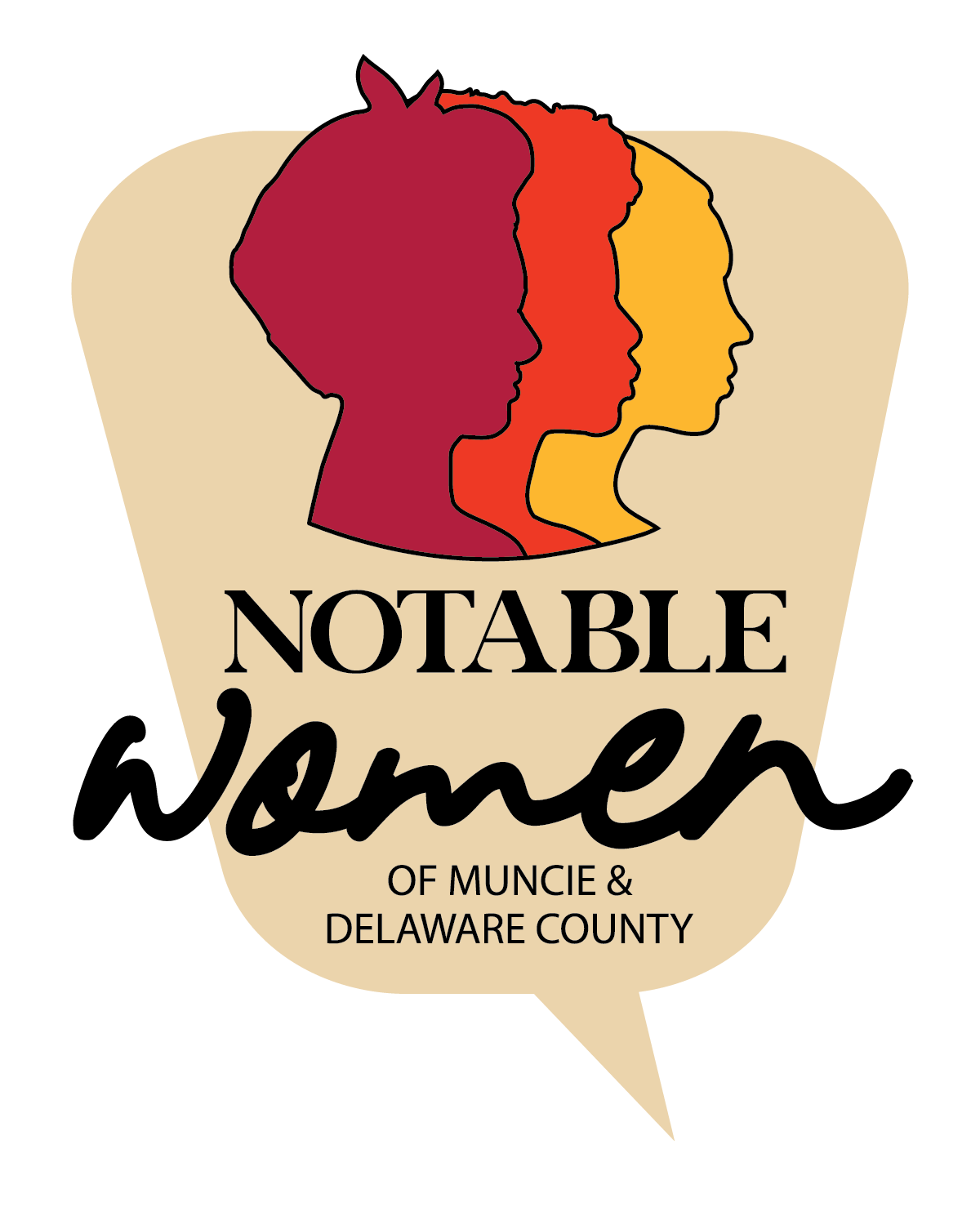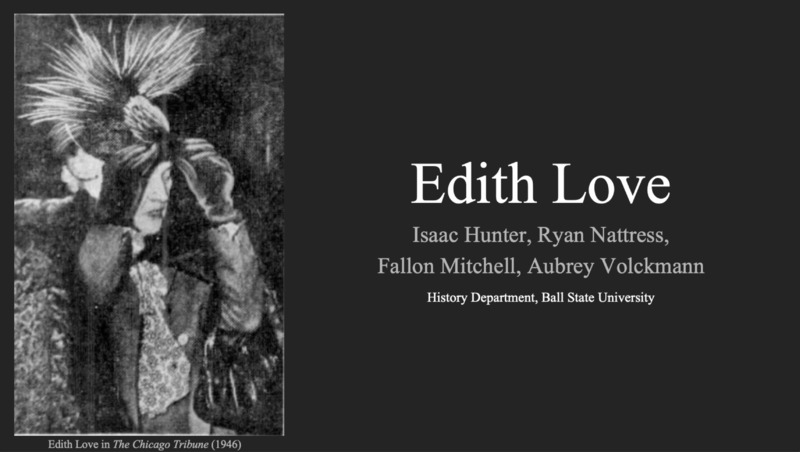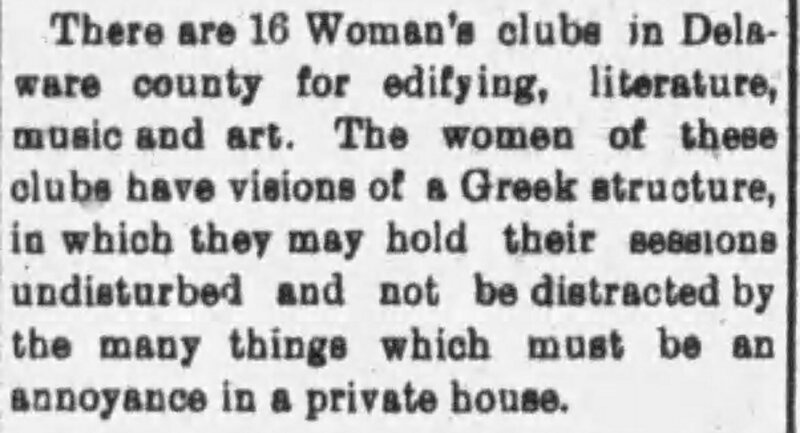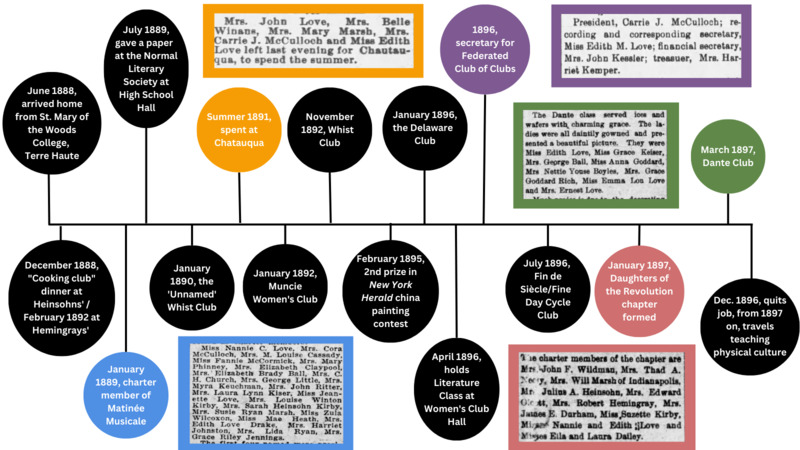Edith Love
From 1880 to 1920, Munsonians participated in many clubs and associations. Each person's participation depended on their class (education and wealth), gender, and race. Edith Love, a white professional class woman, provides an example that transcends Muncie. Newspaper articles reveals that, in the Progressive Era, the small Midwestern city's women participated in activities that were characteristic of similar women in a metropolis like Chicago.
This biographical video was researched and created by Isaac Hunter, Fallon Mitchell, Ryan Nattress, and Aubrey Volckmann in HIST 200-01 (Spring 2023) at Ball State University.
In April 1896, The Muncie Morning News proudly proclaimed that Delaware County hosted sixteen women's clubs. These included religious societies like the Martha and Mary Club, literary societies like the Dickens Club, artistic societies like the Art Students League, and social clubs like the Conversation Club. Many of these groups offered performances or lectures, like the Literature Class and the Matinée Musicale, which required designated spaces like the Women's Club room in the Ball block or the Opera House stage.
Most of all, clubs required members. To maintain sixteen clubs of ten to thirty members each, Delaware County must have had many women with enough wealth and leisure time to support membership. Some women participated in several clubs. As the figure below shows, in the 1880s and 1890s, while Edith Love worked in Muncie as a teacher, she participated in many clubs. Her interests varied: from music to card games to literature and bicycle-riding. Also striking, is how many of the same women joined Edith in multiple clubs. Edith's sisters, Nannie and Emma, Carrie McCulloch, and the Heinsohn, Ryan, Marsh, and Kirby ladies, were all frequent club members. Not surprisingly, they were also members of the city's professional, educated class.
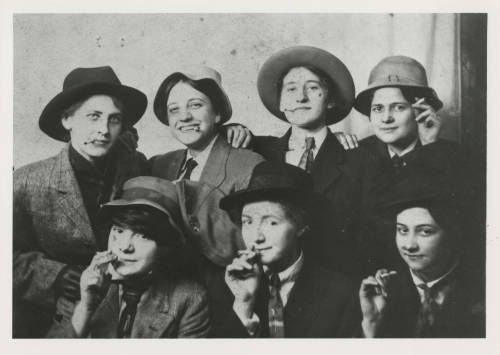
"Dante Club" (c.1885-90), The Marsh and Ryan Family Collection, P.021, Box 3, Archives and Special Collections, University Library, Ball State University.
Education and elite social status also offered women a bit of lee way in their club activities. As the photograph (left) shows, the Dante Club did more than study Italian poetry. Although their formal purpose was to spend Saturday afternoons discussing John Ruskin's Essays on art and literary criticism, Dante Alighieri's Divine Comedy, and Homer's Iliad in translation, cross-dressing at their annual party reveals their irreverent intellectual equality streak. Seven club members are dressed in men's clothes and smoking mock cigarettes. Newspapers tell us that Edith Love, Anna Goddard, Mrs. George A. (née Frances Woodworth) Ball, Mrs. Mildred Ryan Beatty, and Mrs. Susan Ryan Marsh were among the club's ten members. In the mid-1890s, wearing trousers and smoking was considered risqué behavior in Muncie, especially for unmarried or young women. Interestingly, the photographer was John Rollin Marsh, the husband of one of the club members, who clearly supported their scholarship and feminist fun.

"Edith Love's Bicycle Party" (June 29, 1896), Marsh and Ryan Family Collection, Archives and Special Collections, University Libraries, Ball State University. The Muncie Evening Press identified the riders as Edith Love, Hattie and Grace Johnson, Hudie Smith, Reba Richey, Winifred Smith, PR Janney, WB Stevens, Rob Williams, Dietrich Wagner, Ray and AL Johnson, Sam Wilkinson, Ed Ball, Tom Hemingray, Harriet Marsh Johnston, Tom Ryan, Mildred Ryan Beatty, Susan Ryan Marsh and John Rollin Marsh (photographer).
The arrival of the bicycle underlined the freedom that wealth and social status allowed women. In Gas Boom Society, Ned Griner discussed the development of Muncie's cycling clubs. The first Muncie Cycling Club, formed in 1893 when bicycles were still expensive and rare, was limited to sixty "gentlemen," who paid a $3 initiation fee and rented a clubhouse on East Washington Street. By 1896, bicycles were less expensive and more common. The photograph above identifies the people that formed the Fin de Siècle (or Fine Day Cycle) Club. The punning name and the bicycle's expense, along with the cost of a bicycle-riding suit, and the time available for a five-mile ride and picnic, mark this activity as a professional class event.
In 1903, Edith married Lauren Jay Drake Junior. An article in The Star Press reveals the wedding as an opportunity for Muncie to show itself as the social equal of New York where the Drake family lived. The Dante club held a dinner for the bride and twenty-five guests at Oakhurst, the home of George and Frances Ball. An informal dance followed at Muncie's country club. Then Mr. and Mrs. F.C. Ball hosted a dinner for forty guests, at Minnetrista their home, honoring the bridal party and out-of town guests. As the father of the groom had been the general manager of Standard Oil of Indiana, and was then working in New York City, surely the Ball Brothers as local industrialists wished to show their city as equal to such a match. These expensive events leading up to the wedding suggest their interest.
Edith's activities in Chicago between 1937 and 1946 mirror some of her interests in Muncie thirty years earlier. She continued to be an active member of the Daughters of the American Revolution. While Edith took up membership in the Chicago Lawn Women's Club, she adopted more charitable causes in place of her previous intellectual interests. The Travelers' Aid Society and the Chicago Junior School replaced literary and cycling clubs. Perhaps the beginning of war also impacted Edith, encouraging an interest in China and defense issues.
One constant amid these shifts was the continued interest in marriages, especially in high social classes. In Muncie in 1903, Edith's wedding to Lauren Jay Drake Junior was covered attentively by city newspapers, just as her daughters' weddings were in Chicago in the 1930s. Notably, when newspapers announced the weddings of Edith, and her daughters Mary Anthony Drake and Julia Drake (above), the women's professional and educational attainments were included. Sadly, after marriage, these women exchanged their roles for fundraising and club work. Seeing Edith's enthusiastic participation, one might wonder if she missed her work as Director of Physical Culture at Terre Haute's State Normal School.
To find out about the research behind this project and the twists and turns that it took, watch this methodology video, which was researched and created by Isaac Hunter, Fallon Mitchell, Ryan Nattress, and Aubrey Volckmann.
Edith Love came from one of Muncie's pioneering family, which brought wealth and status. She and her sisters attended St. Mary of the Woods College in Terre Haute, worked as teachers, and were part of the city's educated, white, professional class. To explore the life of a Latino woman whose son traveled to Muncie for education, click on Donatila Lizarraga, Madre de Juan Lizarraga.
